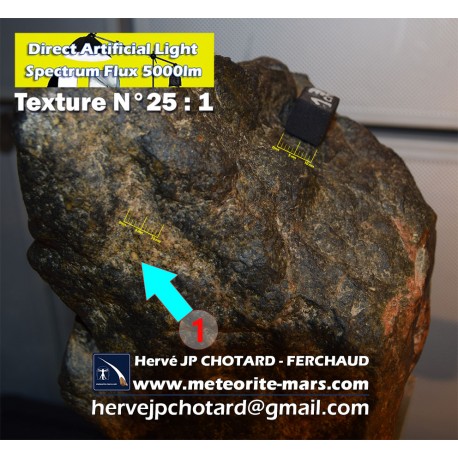French Météorite
This is a cumulate dunite (85% olivine) with an adcumulate texture with small patches rich in interstitial material having an orthocumulate texture 25/3 GROS GRAINS !! similirary dunite Chassignitte !!!! en difference comparatif texture
echelle mm grains fins de martian naklite Mars Meteorite / Martian Meteorite
Part slice with fusion crust
Chassignite est un cumulat, c'est à dire une roche formée par l'accumulation dense d'un ou plusieurs minéraux au fond d'une chambre magmatique. Ici, la roche est presque exclusivement composée d'olivine, ce qui en fait une dunite. Sa composition est la suivante : 91,6 % d'olivine riche en fer, 5 % de pyroxène, 1,7 % de plagioclase et 1,4 % de chromite (riche en Fe3+). Elle renferme également 0,3 % d'inclusions vitreuses (observables par exemple dans les cristaux d'olivine), dans lesquelles on distingue parfois des amphiboles riches en titane (kaersutite). On trouve enfin une foule de minéraux accessoires en très petites quantités : feldspaths alcalins, biotite, oxydes (ilménite, rutile, baddeleyite), sulfures (marcasite, pentlandite, troilite) et phosphates (chlorapatite). Les fractures qui parcourent la roche sont obstruées par des carbonates et des sulfates, ce qui atteste d'une altération par de l'eau liquide...... | 
Northwest Africa 8694 (NWA 8694)MoroccoPurchased: 14 July 2014Classification: Martian meteorite (Chassignite)Physical characteristics: A single 54.80g flattened spherical stone, almost entirely covered by fusions crust.Petrography: (R. Hewins, S. Pont, B. Zanda, MNHNP) This meteorite is a cumulate dunite with 85% highly fractured olivine. It has an adcumulate texture with small patches rich in interstitial material having an orthocumulate texture. The main intercumulus phases are pigeonite and augite, both with very fine (1 μm) exsolution lamellae,and glass. Minor phases include chromite, partly enclosed by olivine, and ilmenite. The olivine contains largely crystalline melt inclusions, surrounded by radial fractures. The main phases in melt inclusions are orthopyroxene and glass; rare phases include apatite, amphibole and mica.Geochemistry: Mineral compositions: (R. Hewins, MNHNP) The olivine composition is Fo53.2±0.3Fa46.8±0.3, with an FeO/MnO ratio of 50.0±1.6, n=24. The crystals are equilibrated in Fe-Mg, but retain a weak depletion of Ca towards crystal rims, with a total range of 0.8–0.29 wt. % CaO. The pigeonite composition is En55.8±0.9Fs37.5±1.0Wo6.7±1.3, n=26, and FeO/MnO of 28.7±1.9; the orthopyroxene is En59.9±0.4Fs37.7±0.9Wo2.4±0.8 and FeO/MnO ratio of 30.2±3.0; and the augite is En40.6±0.2Fs16.1±0.6Wo43.3±0.5, with an FeO/MnO ratio of 27.4±3.2, (neglecting overlap compositions). The orthopyroxene in the melt inclusions varies from En56 to En59, with Al2O3 up to 4 wt.%, whereas interstitial orthopyroxene has only 0.4±0.3 wt.% Al2O3. The amphibole is calcium-rich with 3% TiO2 and the mica is phlogopitic. Apatite has about 2.5 wt.% of each of F and Cl. Geochemistry: (N. Asseyag, P. Cartigny, IPGP). Oxygen isotope analysis gives δ18O=4.74 δ17O=2.78 Δ17O=0.32, (standard errors: ±0.10, ±0.07, ±0.04 respectively).Classification: (R. Hewins, S. Pont and B. Zanda, MNHNP) The meteorite is classified as a chassignite. The textures and mineral assemblages are almost identical to those of Chassigny and NWA 2737. The olivine and pyroxene compositions are intermediate between those of Chassigny and Nakhla. The Fe/Mn ratios of olivine grains fall on to just above the Papike reference line for Mars. Specimens: Specimen: 12.3 g at MNHNP
Météorite Chizé de Mars Communauté texture 25/03 Comparaison SNC ....Naklite Chassignite...echelle en mm grains fins de martian naklite Mars Meteorite / Martian Meteorite / NWA 998 Nakhlit avec sa texture grains fins avec echelle mm et la texture 25/03 Météorite Chizé de Mars Communauté de Mars texture echelle en mm gros grains !!! dunitique !! dunite Météorite Chassigny ..meteorite-mars.com meteorite-mars.com ...... ce qui confirment.........xxxxxxe ........Nicola Marte ....... xxxxxxx... Labenne Meteorites Pierre-Marie Pelé..... Météorite Chizé de Mars Communauté texture 25 dunite chassignite !!
The SNC-meteorites are a group of Achondrite meteorites, by them is assumed, that they originate from the Mars. They own an in comparison with other meteorite low old (about a billion years) and must originate thus from a celestial object, which had still a relatively young geological activity. Besides they includes gases, which correspond to in their composition of the Mars-atmosphere, as they are determined also by measurements of the Viking-probes.
SNC-Meteorites are often made of small mineral grains that can't be seen clearly without a microscope. To see these small grains, scientists grind and polish rock samples very thin (0.03 millimeters) so light can pass through them. This picture is a microscopic view, about 2.3 millimeters across, of a martian meteorite. The brown areas are grains of the mineral pyroxene and the clear white areas are the mineral plagioclase. These are the two most abundant minerals in basalt, both on Earth and Mars. The black areas are magnetite, an iron-oxide mineral.
Northwest Africa 998 [Martian (nakhlite)]
:Collection: Gerald Armstrong James Armstrong
Collection: Gerald Armstrong
Meteorite details Found in 25 collectionsMembers photos (18) abibou
Aeroliths Collection Theodossiou
AJS Cosmic Treasures
Allmeteorite.com
Andreas Grünemeyer
Argus Rocks
bphd
Brice D. Hornback
Chris Spratt
Corry Freeman
David Campbell
David Hardy
Denis gourgues
eraserhead
Gerald Armstrong
J John Lutzon
Jay Piatek
Jim
Jim Strope
MeteoriteCollector.org - FCOM - Russ Finney
Michael S. Scherman
Robert Zdancewicz
simkoz
Solar Anamnesis
xeqtr
http://www.encyclopedia-of-meteorites.com/meteorite.aspx...
Northwest Africa 998 [Martian (nakhlite)]
Meteorite details Found in 25 collectionsMembers photos (18)
Name: Northwest Africa 998
Abbreviation: NWA 998
Country: (Northwest Africa)
(Northwest
Status: Valid
Fall: No
Year: 2001
Class: Martian (nakhlite)
TKW, g: 456
Bibliography: Meteoritical Bulletin 87
For more information see Meteoritical Northwest Africa 998
Basic information Name: Northwest Africa 998
This is an OFFICIAL meteorite name.
Abbreviation: NWA 998
Observed fall: No
Year found: 2001
Country: (Northwest Africa)
Mass:help 456 g
Classification
history:
NHM Catalogue: 5th Edition (2000) Martian (shergottite)
Meteoritical Bulletin: MB 87 (2003) Martian (nakhlite)
MetBase: v. 7.1 (2006) Nakhlite
Recommended: Martian (nakhlite) [explanation]
This is 1 of 19 approved meteorites classified as Martian (nakhlite). [show all]
Search for other: Martian meteorites
Writeuphelp
Writeup from MB 87:
Northwest Africa 998
Algeria or Morocco
Purchased 2001 September
Martian meteorite (nakhlite)
A. and G. Hupé (xHupé) purchased, from dealers at the Tucson Gem and Mineral Show in 2002 February, the main mass from a 456 g stone that had been acquired at an unspecified site in western Algeria or eastern Morocco in 2001 September. Dimensions before cutting: 72 mm by 65 mm by 48 mm. Classification and mineralogy (A. Irving and S. Kuehner, UWS): a friable, dark green rock with minor orange-brown alteration products that probably are of pre-terrestrial origin. It is composed mainly of subhedral, olive-green, complexly zoned subcalcic augite (Fs22Wo39) with subordinate yellow olivine (Fa64), orthopyroxene (Fs49Wo4), interstitial plagioclase (Ab61Or4 containing 0.1 wt% SrO, and exhibiting normal birefringence), titanomagnetite, chlorapatite and pyrrhotite. The overall texture is that of a hypabyssal, adcumulate igneous rock, and the apparent crystallization sequence is olivine, orthopyroxene, titanomagnetite, augite, apatite, plagioclase. There is a weak preferred orientation of prismatic pyroxene crystals, many of which have very distinctive zoning, with cores of augite surrounded by irregular, inverted pigeonite rims (now consisting of orthopyroxene with fine augite lamellae). Trains of tiny melt inclusions are present along healed fractures within pyroxene; microprobe study confirms that most of these are K-Na-Al-bearing silicate glass, but some are intergrowths of glass and Fe-bearing carbonate, which may represent quenched immiscible silicate-carbonate liquids. Symplectitic intergrowths of titanomagnetite and low-Ca pyroxene are present at grain boundaries between large, discrete olivine and titanomagnetite grains, but are not present around chromian titanomagnetite inclusions within olivine. These observations suggest that a pre-terrestrial oxidation process produced the symplectites, and involved high temperature, deuteric fluid infiltration along grain boundaries; such fluids also may have produced the irregular pigeonitic rims on augite crystals. Secondary (probably pre-terrestrial) ankeritic carbonate, K-feldspar (some Fe-bearing), serpentine (?), calcite and a Ca sulfate are present on grain boundaries and within cracks in augite. Oxygen isotope composition (D. Rumble, CIW): replicate analyses of acid-washed augite by laser fluorination gave δ18O = +3.9 ± 0.2‰; δ17O = +2.4 ± 0.1‰; ∆17O = +0.30 ± 0.02‰. Specimens: type specimens, 20 g, UWS, 20 g, FMNH, and two polished thin sections, UWS; main mass, xHupé.
Data from:
MB87
Table 8
Line 32:
Origin or pseudonym: Morocco/Algeria
Place of purchase: Tucson, Az
Date: Sep 2001
Mass (g): 456
Pieces: 1
Class: Martian
Classifier: A. Irving, UWS
Type spec mass (g): 40
Main mass: ROM
Comments: see separate entry
Plots: O isotopes:
Institutions
and collections FMNH: Department of Geology The Field Museum of Natural History 1400 South Lake Shore Drive Chicago, IL 60605-2496, USA, United States; Website (institutional address; updated 16 Nov 2011)
ROM: Royal Ontario Museum, 100 Queen's Park, Toronto, Ontario M5S 2C6, Canada (institutional address; updated 18 Oct 2011)
UWS: University of Washington, Department of Earth and Space Sciences, 70 Johnson Hall, Seattle, WA 98195, United States (institutional address; updated 15 Jan 2012)
CIW: Carnegie Insitution Washington, Geophysical Laboratory, 5251 Broad Branch Rd., NW, Washington DC 20015, United States (institutional address)
xHupé: (old address—now see GHupé or AHupé) G. and A. Hupe, 2616 Lake Youngs Court SE, Renton, WA 98058., United States (private address)
Catalogs:
References: Published in Meteoritical Bulletin, no. 87, MAPS 38, A189-A248 (2003)
Find references in NASA ADS: NASA ADS
Find references in Google Scholar: Google Scholar
Photos:
Credit Photos
Photos uploaded by members of the Encyclopedia of Meteorites.
(Caution, these are of unknown reliability)
abibou Added to database 7 Sep 2012
Aeroliths Collection Theodossiou Added to database 8 Jan 2012
AJS Cosmic Treasures Added to database 16 May 2010
Allmeteorite.com Added to database 29 Mar 2011
Argus Rocks Added to database 16 Aug 2009
bphd Added to database 26 Sep 2010
David Campbell Added to database 2 Sep 2009
Denis gourgues Added to database 24 Apr 2014
Gerald Armstrong Added to database 10 Feb 2010 Added to database 20 Apr 2010
J John Lutzon Added to database 13 Mar 2011
Jay Piatek Added to database 16 Jun 2009
Jim Strope Added to database 14 Feb 2012
MeteoriteCollector.org - FCOM - Russ Finney Added to database 31 Jan 2012
Michael S. Scherman Added to database 5 Jul 2009
Robert Zdancewicz Added to database 8 Nov 2011
Solar Anamnesis Added to database 28 Dec 2016
xeqtr Added to database 7 Feb 2013
Geography:
Coordinates: Unknown.
Statistics:
This is 1 of 5753 approved meteorites from (Northwest Africa) (plus 2068 unapproved names)
Also see:
See what others liked This lists the most popular meteorites among people who looked up this meteorite.
Revision
history:
Revision history This lists important revisions made to data for this record. |












